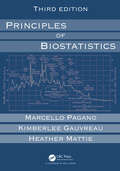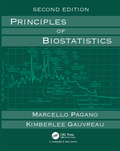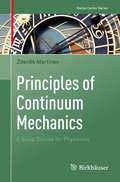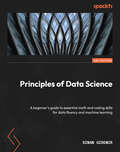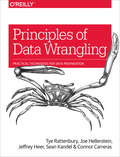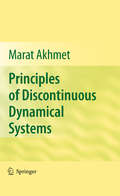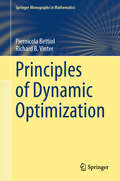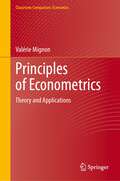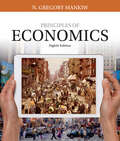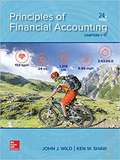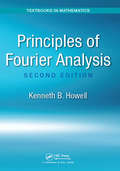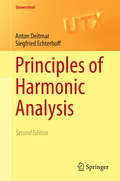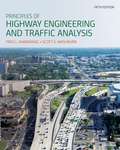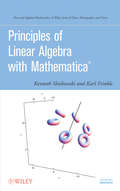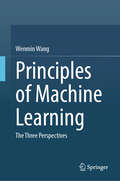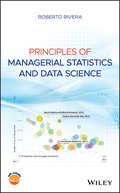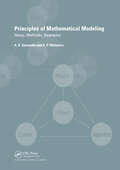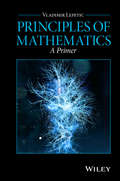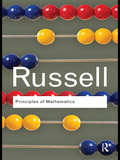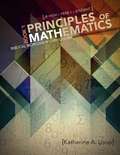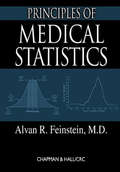- Table View
- List View
Principles of Automated Drafting (Mechanical Engineering Ser. #28)
by Daniel L. RyanThis book introduces the reader to each phase of the subject, step-by-step to enable one to use the various automated drafting devices, instruments and technique of application. It shows the way to produce acceptable drafting in the framework of high productivity.
Principles of Biostatistics
by Marcello Pagano Kimberlee Gauvreau Heather MattiePrinciples of Biostatistics, Third Edition is a concepts-based introduction to statistical procedures that prepares public health, medical, and life sciences students to conduct and evaluate research. With an engaging writing style and helpful graphics, the emphasis is on concepts over formulas or rote memorization. Throughout the book, the authors use practical, interesting examples with real data to bring the material to life. Thoroughly revised and updated, this third edition includes a new chapter introducing the basic principles of Study Design, as well as new sections on sample size calculations for two-sample tests on means and proportions, the Kruskal-Wallis test, and the Cox proportional hazards model. Key Features: Includes a new chapter on the basic principles of study design. Additional review exercises have been added to each chapter. Datasets and Stata and R code are available on the book’s website. The book is divided into three parts. The first five chapters deal with collections of numbers and ways in which to summarize, explore, and explain them. The next two chapters focus on probability and introduce the tools needed for the subsequent investigation of uncertainty. It is only in the eighth chapter and thereafter that the authors distinguish between populations and samples and begin to investigate the inherent variability introduced by sampling, thus progressing to inference. Postponing the slightly more difficult concepts until a solid foundation has been established makes it easier for the reader to comprehend them.
Principles of Biostatistics (Statistics Ser.)
by Marcello Pagano Kimberlee Gauvreau<p>This edition is a reprint of the second edition published in 2000 by Brooks/Cole and then Cengage Learning. <p>Principles of Biostatistics is aimed at students in the biological and health sciences who wish to learn modern research methods. It is based on a required course offered at the Harvard School of Public Health. In addition to these graduate students, many health professionals from the Harvard medical area attend as well. <p>The book is divided into three parts. The first five chapters deal with collections of numbers and ways in which to summarize, explore, and explain them. The next two chapters focus on probability and introduce the tools needed for the subsequent investigation of uncertainty. It is only in the eighth chapter and thereafter that the authors distinguish between populations and samples and begin to investigate the inherent variability introduced by sampling, thus progressing to inference. Postponing the slightly more difficult concepts until a solid foundation has been established makes it easier for the reader to comprehend them.
Principles of Computational Cell Biology: From Protein Complexes to Cellular Networks
by Volkhard HelmsComputational cell biology courses are increasingly obligatory for biology students around the world but of course also a must for mathematics and informatics students specializing in bioinformatics. This book, now in its second edition is geared towards both audiences. The author, Volkhard Helms, has, in addition to extensive teaching experience, a strong background in biology and informatics and knows exactly what the key points are in making the book accessible for students while still conveying in depth knowledge of the subject.About 50% of new content has been added for the new edition. Much more room is now given to statistical methods, and several new chapters address protein-DNA interactions, epigenetic modifications, and microRNAs.
Principles of Continuum Mechanics: A Basic Course for Physicists (Nečas Center Series)
by Zdeněk MartinecThis book addresses the basic concepts of continuum mechanics, that is, the classical field theory of deformable bodies. The theory is systematically developed, from the kinematics to the balance equations, the material theory, and the entropy principles. In turn, the linear-elastic solids, the ideal liquid and the Newtonian liquid are presented in detail as concrete applications. The book concludes by covering the theory of small motions in a medium with a finite prestress. In general, the emphasis is on presenting the content in a clear and straightforward way that requires only an elementary grasp of calculus, linear algebra, and Newtonian mechanics. The book is intended for students of physics, mechanics, engineering and the geosciences, as well as applied mathematics, with a year or more of college calculus behind them.
Principles of Data Science: A beginner's guide to essential math and coding skills for data fluency and machine learning
by Sinan OzdemirTransform your data into insights with must-know techniques and mathematical concepts to unravel the secrets hidden within your dataKey FeaturesLearn practical data science combined with data theory to gain maximum insights from dataDiscover methods for deploying actionable machine learning pipelines while mitigating biases in data and modelsExplore actionable case studies to put your new skills to use immediatelyPurchase of the print or Kindle book includes a free PDF eBookBook DescriptionPrinciples of Data Science bridges mathematics, programming, and business analysis, empowering you to confidently pose and address complex data questions and construct effective machine learning pipelines. This book will equip you with the tools to transform abstract concepts and raw statistics into actionable insights. Starting with cleaning and preparation, you’ll explore effective data mining strategies and techniques before moving on to building a holistic picture of how every piece of the data science puzzle fits together. Throughout the book, you’ll discover statistical models with which you can control and navigate even the densest or the sparsest of datasets and learn how to create powerful visualizations that communicate the stories hidden in your data. With a focus on application, this edition covers advanced transfer learning and pre-trained models for NLP and vision tasks. You’ll get to grips with advanced techniques for mitigating algorithmic bias in data as well as models and addressing model and data drift. Finally, you’ll explore medium-level data governance, including data provenance, privacy, and deletion request handling. By the end of this data science book, you'll have learned the fundamentals of computational mathematics and statistics, all while navigating the intricacies of modern ML and large pre-trained models like GPT and BERT.What you will learnMaster the fundamentals steps of data science through practical examplesBridge the gap between math and programming using advanced statistics and MLHarness probability, calculus, and models for effective data controlExplore transformative modern ML with large language modelsEvaluate ML success with impactful metrics and MLOpsCreate compelling visuals that convey actionable insightsQuantify and mitigate biases in data and ML modelsWho this book is forIf you are an aspiring novice data scientist eager to expand your knowledge, this book is for you. Whether you have basic math skills and want to apply them in the field of data science, or you excel in programming but lack the necessary mathematical foundations, you’ll find this book useful. Familiarity with Python programming will further enhance your learning experience.
Principles of Data Wrangling: Practical Techniques for Data Preparation
by Joseph M. Hellerstein Connor Carreras Jeffrey Heer Sean Kandel Tye RattenburyA key task that any aspiring data-driven organization needs to learn is data wrangling, the process of converting raw data into something truly useful. This practical guide provides business analysts with an overview of various data wrangling techniques and tools, and puts the practice of data wrangling into context by asking, "What are you trying to do and why?"Wrangling data consumes roughly 50-80% of an analyst’s time before any kind of analysis is possible. Written by key executives at Trifacta, this book walks you through the wrangling process by exploring several factors—time, granularity, scope, and structure—that you need to consider as you begin to work with data. You’ll learn a shared language and a comprehensive understanding of data wrangling, with an emphasis on recent agile analytic processes used by many of today’s data-driven organizations.Appreciate the importance—and the satisfaction—of wrangling data the right way.Understand what kind of data is availableChoose which data to use and at what level of detailMeaningfully combine multiple sources of dataDecide how to distill the results to a size and shape that can drive downstream analysis
Principles of Discontinuous Dynamical Systems
by Marat AkhmetDiscontinuous dynamical systems have played an important role in both theory and applications during the last several decades. This is still an area of active research and techniques to make the applications more effective are an ongoing topic of interest. Principles of Discontinuous Dynamical Systems is devoted to the theory of differential equations with variable moments of impulses. It introduces a new strategy of implementing an equivalence to systems whose solutions have prescribed moments of impulses and utilizing special topologies in spaces of piecewise continuous functions. The achievements obtained on the basis of this approach are described in this book. The text progresses systematically, by covering preliminaries in the first four chapters. This is followed by more complex material and special topics such as Hopf bifurcation, Devaney's chaos, and the shadowing property are discussed in the last two chapters. This book is suitable for researchers and graduate students in mathematics and also in diverse areas such as biology, computer science, and engineering who deal with real world problems.
Principles of Dynamic Optimization (Springer Monographs in Mathematics)
by Piernicola Bettiol Richard B. VinterThis monograph explores key principles in the modern theory of dynamic optimization, incorporating important advances in the field to provide a comprehensive, mathematically rigorous reference. Emphasis is placed on nonsmooth analytic techniques, and an in-depth treatment of necessary conditions, minimizer regularity, and global optimality conditions related to the Hamilton-Jacobi equation is given. New, streamlined proofs of fundamental theorems are incorporated throughout the text that eliminate earlier, cumbersome reductions and constructions. The first chapter offers an extended overview of dynamic optimization and its history that details the shortcomings of the elementary theory and demonstrates how a deeper analysis aims to overcome them. Aspects of dynamic programming well-matched to analytical techniques are considered in the final chapter, including characterization of extended-value functions associated with problems having endpoint and state constraints, inverse verification theorems, sensitivity relationships, and links to the maximum principle.This text will be a valuable resource for those seeking an understanding of dynamic optimization. The lucid exposition, insights into the field, and comprehensive coverage will benefit postgraduates, researchers, and professionals in system science, control engineering, optimization, and applied mathematics.
Principles of Econometrics: Theory and Applications (Classroom Companion: Economics)
by Valérie MignonThis textbook teaches the basics of econometrics and focuses on the acquisition of methods and skills that are essential for any student to succeed in their studies, as well as for any practitioner interested in applying econometric techniques. Employing a pedagogical and easy-to-follow style, the book puts into practice the various concepts presented, such as statistics, tests, and methods, among others. Numerous examples and empirical applications using existing econometric and statistical software are given after each theoretical presentation.The book addresses students at the undergraduate and graduate levels in economics and management, as well as students of engineering and business schools. It will further appeal to professionals and practitioners of econometrics, such as economists and researchers in companies and institutions, who will find practical solutions to the different problems they are confronted with.
Principles of Economics
by N. Gregory MankiwNow you can master the principles of economics with the help of the most popular, widely-used economics textbook by students worldwide -- Mankiw�s PRINCIPLES OF ECONOMICS, 8E. With its clear and engaging writing style, this book emphasizes only the material that will help you better understand the world in which you live, will make you a more astute participant in the economy, and will give you a better understanding of both the potential and limits of economic policy. The latest relevant economic examples bring principles to life. Acclaimed text author N. Gregory Mankiw explains, "I have tried to put myself in the position of someone seeing economics for the first time. My goal is to emphasize the material that students should and do find interesting about the study of the economy." Powerful student-focused digital resources are available in leading MindTap and Aplia digital learning and homework solutions that reinforce the principles presented in this edition.
Principles of Economics
by N. Gregory MankiwGain a strong foundation in economics with today's most popular economics text, trusted by students like you worldwide -- Mankiw's PRINCIPLES OF ECONOMICS, 10E. Using a clear, inviting writing style, this edition focuses exclusively on content to help you better understand the world and economy in which you live. You become a more astute participant in today's economic environment as you learn the potential and limits of economic policy. The latest examples and learning features clarify and bring economic principles to life as author Gregory Mankiw puts himself in the position of someone seeing economics for the first time. Dr. Mankiw's goal is to emphasize the material you will find most relevant and interesting as you study economics. MindTap digital resources, Aplia digital homework solution and author videos are also available to help you further master key economic principles.
Principles of Financial Accounting
by John Wild Ken ShawPrinciples of Financial Accounting responds to the market’s request for a financial accounting text with a sole-proprietorship approach. Chapter opening vignettes using dynamic entrepreneurs appeal to all students and show the relevance of accounting. Students are encouraged to think like a businessperson and apply what they learn. A wide variety of assignments provide instructors with materials to teach, assess, and challenge students on several levels.
Principles of Fourier Analysis (Textbooks in Mathematics)
by Kenneth B. HowellFourier analysis is one of the most useful and widely employed sets of tools for the engineer, the scientist, and the applied mathematician. As such, students and practitioners in these disciplines need a practical and mathematically solid introduction to its principles. They need straightforward verifications of its results and formulas, and they need clear indications of the limitations of those results and formulas.Principles of Fourier Analysis furnishes all this and more. It provides a comprehensive overview of the mathematical theory of Fourier analysis, including the development of Fourier series, "classical" Fourier transforms, generalized Fourier transforms and analysis, and the discrete theory. Much of the author's development is strikingly different from typical presentations. His approach to defining the classical Fourier transform results in a much cleaner, more coherent theory that leads naturally to a starting point for the generalized theory. He also introduces a new generalized theory based on the use of Gaussian test functions that yields an even more general -yet simpler -theory than usually presented.Principles of Fourier Analysis stimulates the appreciation and understanding of the fundamental concepts and serves both beginning students who have seen little or no Fourier analysis as well as the more advanced students who need a deeper understanding. Insightful, non-rigorous derivations motivate much of the material, and thought-provoking examples illustrate what can go wrong when formulas are misused. With clear, engaging exposition, readers develop the ability to intelligently handle the more sophisticated mathematics that Fourier analysis ultimately requires.
Principles of Harmonic Analysis
by Anton Deitmar Siegfried EchterhoffThis book offers a complete and streamlined treatment of the central principles of abelian harmonic analysis: Pontryagin duality, the Plancherel theorem and the Poisson summation formula, as well as their respective generalizations to non-abelian groups, including the Selberg trace formula. The principles are then applied to spectral analysis of Heisenberg manifolds and Riemann surfaces. This new edition contains a new chapter on p-adic and adelic groups, as well as a complementary section on direct and projective limits. Many of the supporting proofs have been revised and refined. The book is an excellent resource for graduate students who wish to learn and understand harmonic analysis and for researchers seeking to apply it.
Principles of Highway Engineering and Traffic Analysis (5th Edition)
by Fred L. Mannering Scott S. WashburnThe 5th edition of the Mannering's Principles of Highway Engineering and Traffic Analysis continues to offer a concise approach that covers all the necessary fundamental concepts. New features in this edition include updates and more consistency with the latest edition of the Highway Capacity Manual (HCM); the inclusion of sample FE exam questions, call-out of common mistakes; and added coverage on a qualitative description of the mechanistic approach.
Principles of Linear Algebra with Mathematica
by Karl Frinkle Kenneth M. ShiskowskiA hands-on introduction to the theoretical and computational aspects of linear algebra using Mathematica®Many topics in linear algebra are simple, yet computationally intensive, and computer algebra systems such as Mathematica® are essential not only for learning to apply the concepts to computationally challenging problems, but also for visualizing many of the geometric aspects within this field of study. Principles of Linear Algebra with Mathematica uniquely bridges the gap between beginning linear algebra and computational linear algebra that is often encountered in applied settings, and the commands required to solve complex and computationally challenging problems using Mathematica are provided.The book begins with an introduction to the commands and programming guidelines for working with Mathematica. Next, the authors explore linear systems of equations and matrices, applications of linear systems and matrices, determinants, inverses, and Cramer's rule. Basic linear algebra topics, such as vectors, dot product, cross product, and vector projection are explored, as well as a unique variety of more advanced topics including rotations in space, 'rolling' a circle along a curve, and the TNB Frame. Subsequent chapters feature coverage of linear transformations from Rn to Rm, the geometry of linear and affine transformations, with an exploration of their effect on arclength, area, and volume, least squares fits, and pseudoinverses.Mathematica is used to enhance concepts and is seamlessly integrated throughout the book through symbolic manipulations, numerical computations, graphics in two and three dimensions, animations, and programming. Each section concludes with standard problems in addition to problems that were specifically designed to be solved with Mathematica, allowing readers to test their comprehension of the presented material. All related Mathematica code is available on a corresponding website, along with solutions to problems and additional topical resources.Extensively class-tested to ensure an accessible presentation, Principles of Linear Algebra with Mathematica is an excellent book for courses on linear algebra at the undergraduate level. The book is also an ideal reference for students and professionals who would like to gain a further understanding of the use of Mathematica to solve linear algebra problems.
Principles of Machine Learning: The Three Perspectives
by Wenmin WangConducting an in-depth analysis of machine learning, this book proposes three perspectives for studying machine learning: the learning frameworks, learning paradigms, and learning tasks. With this categorization, the learning frameworks reside within the theoretical perspective, the learning paradigms pertain to the methodological perspective, and the learning tasks are situated within the problematic perspective. Throughout the book, a systematic explication of machine learning principles from these three perspectives is provided, interspersed with some examples. The book is structured into four parts, encompassing a total of fifteen chapters. The inaugural part, titled “Perspectives,” comprises two chapters: an introductory exposition and an exploration of the conceptual foundations. The second part, “Frameworks”: subdivided into five chapters, each dedicated to the discussion of five seminal frameworks: probability, statistics, connectionism, symbolism, and behaviorism. Continuing further, the third part, “Paradigms,” encompasses four chapters that explain the three paradigms of supervised learning, unsupervised learning, and reinforcement learning, and narrating several quasi-paradigms emerged in machine learning. Finally, the fourth part, “Tasks”: comprises four chapters, delving into the prevalent learning tasks of classification, regression, clustering, and dimensionality reduction. This book provides a multi-dimensional and systematic interpretation of machine learning, rendering it suitable as a textbook reference for senior undergraduates or graduate students pursuing studies in artificial intelligence, machine learning, data science, computer science, and related disciplines. Additionally, it serves as a valuable reference for those engaged in scientific research and technical endeavors within the realm of machine learning. The translation was done with the help of artificial intelligence. A subsequent human revision was done primarily in terms of content.
Principles of Managerial Statistics and Data Science
by Roberto RiveraIntroduces readers to the principles of managerial statistics and data science, with an emphasis on statistical literacy of business students Through a statistical perspective, this book introduces readers to the topic of data science, including Big Data, data analytics, and data wrangling. Chapters include multiple examples showing the application of the theoretical aspects presented. It features practice problems designed to ensure that readers understand the concepts and can apply them using real data. Over 100 open data sets used for examples and problems come from regions throughout the world, allowing the instructor to adapt the application to local data with which students can identify. Applications with these data sets include: Assessing if searches during a police stop in San Diego are dependent on driver’s race Visualizing the association between fat percentage and moisture percentage in Canadian cheese Modeling taxi fares in Chicago using data from millions of rides Analyzing mean sales per unit of legal marijuana products in Washington state Topics covered in Principles of Managerial Statistics and Data Science include:data visualization; descriptive measures; probability; probability distributions; mathematical expectation; confidence intervals; and hypothesis testing. Analysis of variance; simple linear regression; and multiple linear regression are also included. In addition, the book offers contingency tables, Chi-square tests, non-parametric methods, and time series methods. The textbook: Includes academic material usually covered in introductory Statistics courses, but with a data science twist, and less emphasis in the theory Relies on Minitab to present how to perform tasks with a computer Presents and motivates use of data that comes from open portals Focuses on developing an intuition on how the procedures work Exposes readers to the potential in Big Data and current failures of its use Supplementary material includes: a companion website that houses PowerPoint slides; an Instructor's Manual with tips, a syllabus model, and project ideas; R code to reproduce examples and case studies; and information about the open portal data Features an appendix with solutions to some practice problems Principles of Managerial Statistics and Data Science is a textbook for undergraduate and graduate students taking managerial Statistics courses, and a reference book for working business professionals.
Principles of Mathematical Modelling: Ideas, Methods, Examples (Numerical Insights)
by Alexander A. Samarskii Alexander P. MikhailovMathematical modeling is becoming increasingly versatile and multi-disciplinary. This text demonstrates the broadness of this field as the authors consider the principles of model construction and use common approaches to build models from a range of subject areas. The book reflects the interests and experiences of the authors, but it explores math
Principles of Mathematics
by Vladimir LepeticPresents a uniquely balanced approach that bridges introductory and advanced topics in modern mathematics An accessible treatment of the fundamentals of modern mathematics, Principles of Mathematics: A Primer provides a unique approach to introductory andadvanced mathematical topics. The book features six main subjects, whichcan be studied independently or in conjunction with each other including: settheory; mathematical logic; proof theory; group theory; theory of functions; andlinear algebra. The author begins with comprehensive coverage of the necessary building blocks in mathematics and emphasizes the need to think abstractly and develop an appreciation for mathematical thinking. Maintaining a useful balance of introductory coverage and mathematical rigor, Principles of Mathematics: A Primer features: Detailed explanations of important theorems and their applications Hundreds of completely solved problems throughout each chapter Numerous exercises at the end of each chapter to encourage further exploration Discussions of interesting and provocative issues that spark readers' curiosity and facilitate a better understanding and appreciation of the field of mathematics Principles of Mathematics: A Primer is an ideal textbook for upper-undergraduate courses in the foundations of mathematics and mathematical logic as well as for graduate-level courses related to physics, engineering, and computer science. The book is also a useful reference for readers interested in pursuing careers in mathematics and the sciences. Vladimir Lepetic, PhD, is Professor in the Department of Mathematical Sciences at DePaul University. His research interests include mathematical physics, set theory, foundations of mathematics, and the philosophy of mathematics.
Principles of Mathematics (Routledge Classics)
by Bertrand RussellFirst published in 1903, Principles of Mathematics was Bertrand Russell’s first major work in print. It was this title which saw him begin his ascent towards eminence. In this groundbreaking and important work, Bertrand Russell argues that mathematics and logic are, in fact, identical and what is commonly called mathematics is simply later deductions from logical premises. Highly influential and engaging, this important work led to Russell’s dominance of analytical logic on western philosophy in the twentieth century.
Principles of Mathematics: Book 1
by Katherine A. LoopThis is Year 1 of a two-year math course designed to give students a firm mathematical foundation, both academically and spiritually. Not only does the curriculum build mathematical thinking and problem-solving skills, it also shows students how a biblical worldview affects our approach to math's various concepts. Students learn to see math, not as an academic exercise, but as a way of exploring and describing consistencies God created and sustains. The worldview is not just an addition to the curriculum, but the starting point. Science, history, and real life are integrated throughout.
Principles of Medical Statistics
by Alvan R. FeinsteinThe get-it-over-with-quickly approach to statistics has been encouraged - and often necessitated - by the short time allotted to it in most curriculums. If included at all, statistics is presented briefly, as a task to be endured mainly because pertinent questions may appear in subsequent examinations for licensure or other certifications. However,
Principles of Microeconomics
by N. Gregory MankiwProvide an inviting, superbly written introduction to microeconomics that allows all types of students to quickly grasp microeconomic concepts and build a strong foundation. The most widely-used learning solution in economics classrooms worldwide, written by acclaimed author and economist Gregory Mankiw, PRINCIPLES OF MICROECONOMICS, 9E focuses on the most important microeconomic principles to avoid overwhelming students with excessive detail. Extensive updates, relevant contemporary examples and carefully crafted content present the understanding your students need at key moments in your course. This edition works seamlessly with the latest MindTap digital course solutions and powerful student-focused resources, featuring the highly acclaimed Graph Builder and enhanced Adaptive Test Prep. A team of award-winning teaching economists have further strengthened this edition's leading ancillary support with more relevance, engagement, and interactive learning opportunities.

